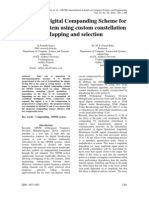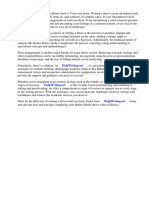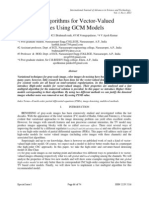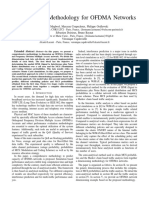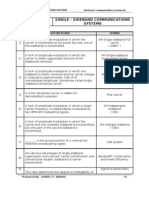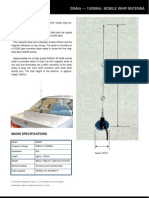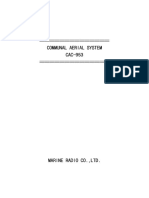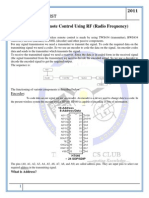0 ratings0% found this document useful (0 votes)
58 viewsMatlab Simulation For Com
Matlab Simulation For Com
Uploaded by
Ravi YarrabothuThis document describes a Matlab simulation that compares different QAM constellations and mappings using bit error rate as the comparison metric. It discusses 7 different 16-QAM constellations tested in the simulation. The results show that a square constellation with points at (3,1,-1,-3) had the lowest bit error rate, making it most suitable for a channel with additive white Gaussian noise. Non-uniform constellations generally had higher bit error rates than uniform constellations as the coefficient describing the inner points increased.
Copyright:
© All Rights Reserved
Available Formats
Download as PDF, TXT or read online from Scribd
Matlab Simulation For Com
Matlab Simulation For Com
Uploaded by
Ravi Yarrabothu0 ratings0% found this document useful (0 votes)
58 views4 pagesThis document describes a Matlab simulation that compares different QAM constellations and mappings using bit error rate as the comparison metric. It discusses 7 different 16-QAM constellations tested in the simulation. The results show that a square constellation with points at (3,1,-1,-3) had the lowest bit error rate, making it most suitable for a channel with additive white Gaussian noise. Non-uniform constellations generally had higher bit error rates than uniform constellations as the coefficient describing the inner points increased.
Original Description:
Matlab simulation for communication
Original Title
Matlab Simulation for Com
Copyright
© © All Rights Reserved
Available Formats
PDF, TXT or read online from Scribd
Share this document
Did you find this document useful?
Is this content inappropriate?
This document describes a Matlab simulation that compares different QAM constellations and mappings using bit error rate as the comparison metric. It discusses 7 different 16-QAM constellations tested in the simulation. The results show that a square constellation with points at (3,1,-1,-3) had the lowest bit error rate, making it most suitable for a channel with additive white Gaussian noise. Non-uniform constellations generally had higher bit error rates than uniform constellations as the coefficient describing the inner points increased.
Copyright:
© All Rights Reserved
Available Formats
Download as PDF, TXT or read online from Scribd
Download as pdf or txt
0 ratings0% found this document useful (0 votes)
58 views4 pagesMatlab Simulation For Com
Matlab Simulation For Com
Uploaded by
Ravi YarrabothuThis document describes a Matlab simulation that compares different QAM constellations and mappings using bit error rate as the comparison metric. It discusses 7 different 16-QAM constellations tested in the simulation. The results show that a square constellation with points at (3,1,-1,-3) had the lowest bit error rate, making it most suitable for a channel with additive white Gaussian noise. Non-uniform constellations generally had higher bit error rates than uniform constellations as the coefficient describing the inner points increased.
Copyright:
© All Rights Reserved
Available Formats
Download as PDF, TXT or read online from Scribd
Download as pdf or txt
You are on page 1of 4
Conference of Informatics and Management Sciences
ICTIC 2013
March, 25. - 29. 2013
Matlab Simulation for Comparison of Different QAM
Constellations and Mapping for a Channel with
Additive White Gausian Noise
Miroslav Makarov
Department of Communication Equipment and Technologies
Technical University of Gabrovo
Gabrovo, Bulgaria
miro.makarov@yahoo.com
Abstract This paper presents a Matlab based simulation that
compares different QAM (Quadrature Amplitude Modulation)
constellations. It also allows to compare two constellations of the
same shape, but with different mapping of the bits. The
simulation includes seven main steps. The criterium for the
comparison is the Bit Error Rate (BER). Seven different
constellations are chosen for study.
Keywords- Matlab simulation; QAM; constellations; BER;
mapping
I.
INTRODUCTION
The goal is to realize a simulation technique, that compares
different QAM (Quadrature Amplitude Modulation)
constellations and mapping schemes using Matlab. The chosen
criterium is the Bit Error Rate (BER). That allows the most
suitable QAM, constellation and mapping for the situation to
be selected.
II.
MAIN SIMULATION STEPS [6]
A. Loading the input data for the simulation
The simulation gives the opportunity to choose the input
signal between a real signal (audio signal) or an random
generated bit stream. They are loaded into Matlab workspace.
The use of real audio file is prefered, because it is convenient
to hear the changes, introduced by the channel (changes in
frequency band, introduction of noise and so on)[5].
B. Perform ADC (Analog to Digital Conversion)
This step involves the Analog to Digital Conversion if an
real audio signal is selected as input data for the simulation.
C. Chose the QAM to be compared
The constellations may be: square QAM constellation,
performed by the qammod function in Matlab and custom
QAM constellation performed by the genqammod function[6].
For the custom mode the constellation points must be entered
point by point. It is convenient this way because it allows to
compare two or more constellations, that have the same shape,
but use different mapping.
The 2nd International Conference
http://www.ictic.sk
D. Add noise to the signal
This step involves addition of additive white Gaussian
noise to the modulated signal. In order to plot the BER curves a
loop is used, where the loop variable is the Signal to Noise
Ratio (SNR).
E. Demodulate the received QAM signal
In this step the demodulation of the received signal is
performed and is made separately for every different value of
the SNR.
F. Plotting the BER curves
This step involves bitwise comparison of the input and the
received bit streams and plot the BER curves.
G. Digital to Analog Conversion (DAC)
This step is required only if further research of the changes,
introduced by the channel will be made.
III.
CHOSING THE QAM ORDER, CONSTELLATION AND
MAPPING
Seven different 16 QAM constellations and mapping are
chosen [1],[2]. They are shown on the figures below. They are
as follows:
Fig.1 shows 16 QAM square constellation with points (4, 2,
-2, -4) and mapped according DVB-T standard [3],[4].
Fig.2 shows 16 QAM square constellation with points (6, 4,
-4, -6) and mapped according DVB-T standard [3],[4].
Fig.3 shows 16 QAM square constellation with points (3, 1,
-1, -3) .
Fig.4 shows 16 QAM circular constellation with two
amplitudes (1 and 3).
Fig.5 shows 16 QAM circular constellation with 2
amplitudes (3 and 5).
Fig.6 shows 16 QAM circular constellation with 4
amplitudes (1, 3, 5 and 7).
SECTION
7. Information and Communication Technology
- 297 -
Conference of Informatics and Management Sciences
ICTIC 2013
March, 25. - 29. 2013
Figure 1. 16 QAM square constellation with points (4, 2, -2, -4) and mapped
according DVB-T standard
Figure 3. 16 QAM square constellation with points (3, 1, -1, -3)
Figure 2. 16 QAM square constellation with points (6, 4, -4, -6) and mapped
according DVB-T standard
Figure 4. 16 QAM circular constellation with two amplitudes (1 and 3)
The 2nd International Conference
http://www.ictic.sk
SECTION
7. Information and Communication Technology
- 298 -
Conference of Informatics and Management Sciences
ICTIC 2013
March, 25. - 29. 2013
DVB-T standard; 5 corresponds to fig.4; 6 corresponds to
fig. 5 and 7 corresponds to fig. 6.
Figure 5. 16 QAM circular constellation with 2 amplitudes (3 and 5)
Figure 7. BER curves for the 7 different 16 QAM constellations and/or
mapping
Figure 6. 16 QAM circular constellation with 4 amplitudes (1, 3, 5 and 7)
IV.
RESULTS OF THE SIMULATION
The results of the simulations are given on figure 7. It
represents the BER behavior of the different 16 QAM
constellations. The BER curves are as follows: 1- corresponds
to fig. 1; 2 corresponds to fig. 2; 3 and 4 correspond to
fig.3, where 3 is Matlab mapped and 4 is mapped according the
The 2nd International Conference
http://www.ictic.sk
It shows the BER curves in the range from BER = 10-1 to
BER = 10-4.5. It can be seen that the most suitable constellation
for a channel with additive white Gaussian noise is the square
constellation with point coordinates {3; 1; -1; -3}, given on
figure 3. The mapping method does not influence considerably
the BER curves. The most unsuitable constellation is the Nonuniform square constellation with a=4. The constellation is
given on figure 2 and the BER curve is on figure 7, marked
with a 2. It can be seen from the results, that the non-uniform
square constellations (fig.1 and fig. 2) have worse BER
performance than the uniform constellation. The BER
deteriorates with the increase of the coefficient a. The
coefficient a corresponds to the module of the coordinates of
the inner points (i.e. for constellation points 4;2;-2;-4 a=2,
and for constellation points 6; 4; -4; -6 a=4) . The case of the
circular constellation with only 2 amplitudes is the opposite:
the constellation from figure 5 (amplitudes 3 and 5) has better
BER performance than the constellation from figure 4
(amplitudes 1 and 3). The constellation, given on figure 6 has
almost the same BER performance like the constellation on
figure 2. The BER performance of that constellation versus the
increase of the coefficient a will be further researched.
SECTION
7. Information and Communication Technology
- 299 -
Conference of Informatics and Management Sciences
ICTIC 2013
March, 25. - 29. 2013
V.
advisor Assoc. Prof. Nikolay Tashkov for the helpful
discussion.
CONCLUSIONS
In this paper a Matlab based simulation model is
proposed. The obtained BER vs. SNR curves are for seven
different constellations and/or mapping, all 16 QAM. From
the so plotted BER curves and the constellations it can be
clearly seen which one is the most suitable for a given case,
according to transmitted power, SNR and desired BER. The
so proposed Matlab simulation gives good opportunity this
comparison to be made.
REFERENCES
[1]
[2]
[3]
[4]
[5]
ACKNOWLEDGEMENT
The author wishes to thank the reviewers, whose
constructive comments and suggestions improved the
presentation of this paper. Thanks also to the authors PhD
The 2nd International Conference
http://www.ictic.sk
[6]
Webb, W., L. Hanzo. Modern quadrature amplitude modulation.
Principles and applications for fixed and wireless communications,
IEEE PRESS, 1994.
Proakis, J.G. Digital communication. IEEE Press London, 1988.
Konov, K. Digital radio and television broadcast, DIOS, Sofia, 2011.
DVB-T Standard ETSI EN 300 744 V1.6.1 (2009-01)
Tashkov, N., M. Makarov. BER Research for QAM Modulation.
International scientific conference UNITECH11, 18-19 November
2011, Gabrovo, Bulgaria, pp. 322-326.
MathWorks, www.mathworks.com, available: March, 2013
SECTION
7. Information and Communication Technology
- 300 -
You might also like
- Constellation of BPSK and QPSK Usin Matlab MaterialDocument4 pagesConstellation of BPSK and QPSK Usin Matlab MaterialImmanuel VinothNo ratings yet
- Alasalaa 06 En07Document9 pagesAlasalaa 06 En07arash mohtaramiNo ratings yet
- American International University-Bangladesh: Department of Computer EngineeringDocument4 pagesAmerican International University-Bangladesh: Department of Computer EngineeringShahariar Kabir ShuvoNo ratings yet
- BER Performance For M-ARY Digital CommunicationDocument3 pagesBER Performance For M-ARY Digital CommunicationOPTICALMIMOOFDMNo ratings yet
- Comms2 Exp6Document11 pagesComms2 Exp6Airell Francis de VeraNo ratings yet
- Approximating Curve by A Single Segment of B-Splin PDFDocument9 pagesApproximating Curve by A Single Segment of B-Splin PDFTrivianniNo ratings yet
- Blind Equalization of Cross-QAM SignalsDocument4 pagesBlind Equalization of Cross-QAM SignalsShafayat AbrarNo ratings yet
- Gambit: A Tool For The Simultaneous Placement and Detailed Routing of Gate-ArraysDocument11 pagesGambit: A Tool For The Simultaneous Placement and Detailed Routing of Gate-ArraysKeshav RaoNo ratings yet
- Simulink-Based Simulation of Quadrature Amplitude Modulation (QAM) SystemDocument8 pagesSimulink-Based Simulation of Quadrature Amplitude Modulation (QAM) SystemVeronica HansonNo ratings yet
- Nakagami-M Fading ChannelsDocument11 pagesNakagami-M Fading ChannelsSisir KalitaNo ratings yet
- Exact Bit Error Probability of - QAM Modulation Over Flat Rayleigh Fading ChannelsDocument3 pagesExact Bit Error Probability of - QAM Modulation Over Flat Rayleigh Fading ChannelsChàngNgốc VôTìnhNo ratings yet
- Application of Neural Networks in Space-Mapping Optimization of Microwave FiltersDocument8 pagesApplication of Neural Networks in Space-Mapping Optimization of Microwave Filterslucky6519No ratings yet
- Euclidean DistanceDocument10 pagesEuclidean Distanceabyss2000No ratings yet
- Analysis of Propagation Model in Conformance With IEEE 802.16-2009-Based Fixed Wireless NetworksDocument6 pagesAnalysis of Propagation Model in Conformance With IEEE 802.16-2009-Based Fixed Wireless NetworksJoseVelascoNo ratings yet
- A Flexible OFDM System Simulation Model With BER Performance TestDocument10 pagesA Flexible OFDM System Simulation Model With BER Performance Testnamhoa02No ratings yet
- Smooth GPU TessellationDocument9 pagesSmooth GPU TessellationAde LadeNo ratings yet
- Ousman & Zekarias AssignmentDocument14 pagesOusman & Zekarias AssignmentzekariasNo ratings yet
- Coded Bandwidth Efficiency Plane: Spring Semester 2013Document6 pagesCoded Bandwidth Efficiency Plane: Spring Semester 2013Fatima AdlyNo ratings yet
- Ijet V3i2p12Document4 pagesIjet V3i2p12International Journal of Engineering and TechniquesNo ratings yet
- Ofdm Articl SimulDocument8 pagesOfdm Articl SimulazerNo ratings yet
- Efficient Algorithms For Constant-Modulus Analog BeamformingDocument16 pagesEfficient Algorithms For Constant-Modulus Analog Beamformingxiao zhanNo ratings yet
- Title: Status: Purpose: Author(s) or Contact(s)Document4 pagesTitle: Status: Purpose: Author(s) or Contact(s)Shafayet UddinNo ratings yet
- Buchau PaperDocument6 pagesBuchau PaperjuenkkinNo ratings yet
- EE4513 Analog and Digital Communications Laboratory: Non-Rectangular Constellation Quadrature Amplitude Modulation (QAM)Document2 pagesEE4513 Analog and Digital Communications Laboratory: Non-Rectangular Constellation Quadrature Amplitude Modulation (QAM)swvhitNo ratings yet
- Multicast Beam Forming DataDocument15 pagesMulticast Beam Forming DataAadil ShNo ratings yet
- Performance Analysis of BPSK, QPSK & QAM Over AWGN ChannelDocument6 pagesPerformance Analysis of BPSK, QPSK & QAM Over AWGN Channelindersinghkulyal304No ratings yet
- On The Use of Channel Models and Channel Estimation Techniques For Massive MIMO SystemsDocument5 pagesOn The Use of Channel Models and Channel Estimation Techniques For Massive MIMO SystemsHenry Lois Davila AndradeNo ratings yet
- The Adaptive Cross-Approximation Technique For The 3-D Boundary-Element Method PDFDocument4 pagesThe Adaptive Cross-Approximation Technique For The 3-D Boundary-Element Method PDFJonathan MillerNo ratings yet
- Quad Layouts Via Constrained T-Mesh QuantizationDocument10 pagesQuad Layouts Via Constrained T-Mesh QuantizationChadNo ratings yet
- Accurate Design of Pyramidal Horn Antenna PDFDocument2 pagesAccurate Design of Pyramidal Horn Antenna PDFవేలుసామి లింగాసామి100% (1)
- Coil Survey DisingerDocument10 pagesCoil Survey Disingermoonrock1No ratings yet
- CST Application Note Designing Phased Array AntennaDocument6 pagesCST Application Note Designing Phased Array AntennaMertKarahanNo ratings yet
- Mwjournal Jan 2004Document4 pagesMwjournal Jan 2004tavoosiNo ratings yet
- LAB 4 ASSIGNMENT FridayDocument3 pagesLAB 4 ASSIGNMENT FridayKhaleda Akhter SathiNo ratings yet
- Higher Order Finite-Difference Frequency-Domain Analysis of Two-Dimensional Photonic Crystals With Arbitrary ShapesDocument4 pagesHigher Order Finite-Difference Frequency-Domain Analysis of Two-Dimensional Photonic Crystals With Arbitrary ShapesShilongSunNo ratings yet
- Digital Q AmDocument8 pagesDigital Q AmSarah J SinfuegoNo ratings yet
- Optimal Modulation and Coding For Spatial Multiplexing Under Flat Fading ChannelDocument4 pagesOptimal Modulation and Coding For Spatial Multiplexing Under Flat Fading ChannelIOSRJEN : hard copy, certificates, Call for Papers 2013, publishing of journalNo ratings yet
- Improved Butler Matrix Configuration For Smart Beamforming OperationsDocument4 pagesImproved Butler Matrix Configuration For Smart Beamforming OperationsJoyce GeorgeNo ratings yet
- AI Based Digital Companding Scheme For OFDM System Using Custom Constellation Mapping and SelectionDocument6 pagesAI Based Digital Companding Scheme For OFDM System Using Custom Constellation Mapping and SelectionArindam BanerjeeNo ratings yet
- Butler Matrix ThesisDocument7 pagesButler Matrix ThesisFinishedCustomWritingPaperToledo100% (2)
- Denoising Algorithms For Vector-Valued Images Using GCM ModelsDocument9 pagesDenoising Algorithms For Vector-Valued Images Using GCM ModelsRakeshconclaveNo ratings yet
- CMB Parameter EstimationDocument13 pagesCMB Parameter EstimationlordpeafuxNo ratings yet
- 2014 03 31 Bach-GLC-pham-finalizing PDFDocument6 pages2014 03 31 Bach-GLC-pham-finalizing PDFBách Vũ TrọngNo ratings yet
- m2019 Pathloss ModelDocument6 pagesm2019 Pathloss ModelChetan BhatNo ratings yet
- Multiplier Blocks Using Carry-Save Adders: Oscar Gustafsson, Andrew G. Dempster, and Lars WanhammarDocument4 pagesMultiplier Blocks Using Carry-Save Adders: Oscar Gustafsson, Andrew G. Dempster, and Lars WanhammarMurali KrishnaNo ratings yet
- Space-Time Block Coded Spatial Modulation Aided Mmwave Mimo With Hybrid PrecodingDocument6 pagesSpace-Time Block Coded Spatial Modulation Aided Mmwave Mimo With Hybrid PrecodingengineeryasinNo ratings yet
- Digital Modulation I August09Document14 pagesDigital Modulation I August09gzb012No ratings yet
- Dimensioning Methodology For OFDMA NetworksDocument9 pagesDimensioning Methodology For OFDMA Networkskashif416No ratings yet
- Unintended Effects of Asymmetric Return Vias and Via Array Design For Reduced Mode ConversionDocument6 pagesUnintended Effects of Asymmetric Return Vias and Via Array Design For Reduced Mode ConversionnshNo ratings yet
- 1 PB PDFDocument10 pages1 PB PDFLuisNo ratings yet
- OMNIVIS09Document9 pagesOMNIVIS09Rudolf CickoNo ratings yet
- A Novel Compact Butler Matrix Without Phase Shifter: Ge Tian, Jin-Ping Yang, and Wen WuDocument3 pagesA Novel Compact Butler Matrix Without Phase Shifter: Ge Tian, Jin-Ping Yang, and Wen WudhvbkhnNo ratings yet
- Cmos Design of A Multi - Input Analog Multiplier and Divider Circuit (#117087) - 99305Document8 pagesCmos Design of A Multi - Input Analog Multiplier and Divider Circuit (#117087) - 99305Khiêm LêNo ratings yet
- DC Lab Manual Simulation ExperimentsDocument29 pagesDC Lab Manual Simulation Experimentsrobinmyow211No ratings yet
- Reservoir Monitoring and CharacterizationDocument10 pagesReservoir Monitoring and Characterizationopio jamesNo ratings yet
- A Simple Data Pre-Distortion Technique For Satellite Communications: Design & Implementation On Altera DSP BoardDocument6 pagesA Simple Data Pre-Distortion Technique For Satellite Communications: Design & Implementation On Altera DSP BoardIon CapcanariNo ratings yet
- QSM ModulationDocument9 pagesQSM ModulationAsma Bouhlel YounesNo ratings yet
- Refined MISKAM Simulations of The Mock Urban Setting TestDocument6 pagesRefined MISKAM Simulations of The Mock Urban Setting TestMárton BalczóNo ratings yet
- Spline and Spline Wavelet Methods with Applications to Signal and Image Processing: Volume III: Selected TopicsFrom EverandSpline and Spline Wavelet Methods with Applications to Signal and Image Processing: Volume III: Selected TopicsNo ratings yet
- Ieee PoliciesDocument84 pagesIeee PoliciesRavi YarrabothuNo ratings yet
- Farpoint Group 4G and Beyond December 2008Document17 pagesFarpoint Group 4G and Beyond December 2008Ravi YarrabothuNo ratings yet
- Introduction To 3G, GSM, GPRS, EDGE NetworkDocument22 pagesIntroduction To 3G, GSM, GPRS, EDGE NetworkRavi YarrabothuNo ratings yet
- Kanchi TeluguDocument2 pagesKanchi TeluguRavi YarrabothuNo ratings yet
- Brihat JatakaDocument306 pagesBrihat JatakaRavi YarrabothuNo ratings yet
- Site Installation Overview V1.0 20131021 - LabelDocument1 pageSite Installation Overview V1.0 20131021 - LabelOussama VernalNo ratings yet
- Single - Sideband Communications Systems: # Definitions TermsDocument30 pagesSingle - Sideband Communications Systems: # Definitions TermsRalph Reyes SantelicesNo ratings yet
- Ma500 CatalogDocument1 pageMa500 CatalogFatima ShahNo ratings yet
- Brochure SRT 4950H - en PDFDocument2 pagesBrochure SRT 4950H - en PDFpurethingNo ratings yet
- ES 4 Antennas)Document2 pagesES 4 Antennas)Balumahendran SubramanianNo ratings yet
- Lecture 4 - Modeling Cellular SystemsDocument20 pagesLecture 4 - Modeling Cellular SystemsAbdulrahmanNo ratings yet
- 07 Workshop Brochure 2Document4 pages07 Workshop Brochure 2shankar sachinNo ratings yet
- Ic GM651Document36 pagesIc GM651宋翔No ratings yet
- Samsung 32M5300 Training ManualDocument46 pagesSamsung 32M5300 Training ManualRicardo CardenasNo ratings yet
- Telecom Lte Rno Engineer ResumeDocument5 pagesTelecom Lte Rno Engineer Resumerishisethi0% (1)
- Huawei 3606Document3 pagesHuawei 3606kenbk8765No ratings yet
- Unit-Iv Angle ModulationDocument2 pagesUnit-Iv Angle ModulationhimeshemraanNo ratings yet
- CommScope - In-Building Wireless Solutions PDFDocument19 pagesCommScope - In-Building Wireless Solutions PDFculeros1No ratings yet
- Request Stock & Price July 23Document35 pagesRequest Stock & Price July 23Rafael RogelNo ratings yet
- Main Catalogue Edition 5 enDocument185 pagesMain Catalogue Edition 5 enForward MyanmarNo ratings yet
- ELL815 MIMO Wireless Communications Course HandoutDocument2 pagesELL815 MIMO Wireless Communications Course HandoutKeshav AwasthiNo ratings yet
- Electronic CommunicationDocument2 pagesElectronic CommunicationHet PatelNo ratings yet
- Outdoor Directional Dual-Band Antenna: ODV-065R15M18J-GDocument3 pagesOutdoor Directional Dual-Band Antenna: ODV-065R15M18J-GAlex PereiraNo ratings yet
- Iq - Link - Microwave Engineering Record: Low Reference HighDocument2 pagesIq - Link - Microwave Engineering Record: Low Reference HighJose FontanilloNo ratings yet
- 3g Handover Detailed DocumentDocument434 pages3g Handover Detailed Documentadam_imam100% (1)
- Lab 4 - Model Referencing and Angle ModulationDocument6 pagesLab 4 - Model Referencing and Angle Modulationprogressksb50% (2)
- CH3000 HT3300H 1.2 GHZ Double-Density 1310 NM Transmitter System Data SheetDocument7 pagesCH3000 HT3300H 1.2 GHZ Double-Density 1310 NM Transmitter System Data SheetNervin SuarezNo ratings yet
- Tongyu: Xxxxxpol 1710 2690Mhz×5 65° 17.5dbi 2° 10° Integrated and Replaceable Rcu (Remote Control Unit) AntennaDocument1 pageTongyu: Xxxxxpol 1710 2690Mhz×5 65° 17.5dbi 2° 10° Integrated and Replaceable Rcu (Remote Control Unit) AntennaОлександр ЧугайNo ratings yet
- Microwave DD of 359021-359034Document7 pagesMicrowave DD of 359021-359034ToVanNo ratings yet
- Sim840w - FCC Test Report - Part 22h&24e-4Document57 pagesSim840w - FCC Test Report - Part 22h&24e-4mtclimaNo ratings yet
- Cac 953Document9 pagesCac 953Tammy Jim TanjutcoNo ratings yet
- RT7000-PMR WebDocument4 pagesRT7000-PMR WebGhribiNo ratings yet
- Tutorial The Robotics Club SNIST: EncoderDocument7 pagesTutorial The Robotics Club SNIST: EncoderGeovane BarbosaNo ratings yet
- Design and Implementation of Aperture Coupled Microstrip IFF AntennaDocument5 pagesDesign and Implementation of Aperture Coupled Microstrip IFF Antennayeyegak481No ratings yet
- Table Cards DTH - STBDocument6 pagesTable Cards DTH - STBharishjoshinainitalNo ratings yet







































